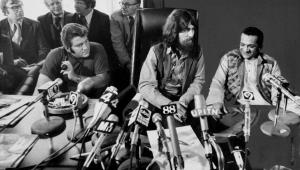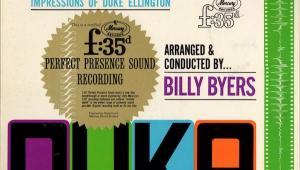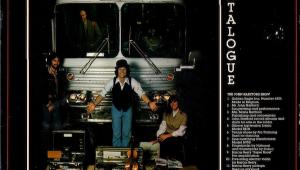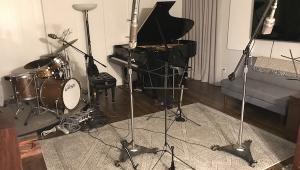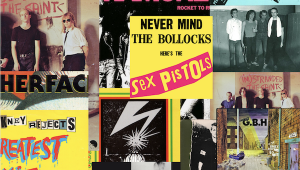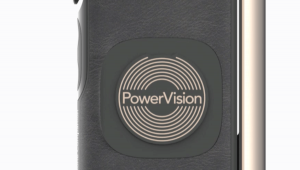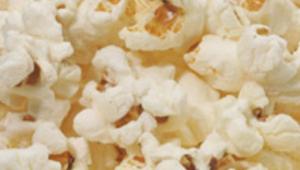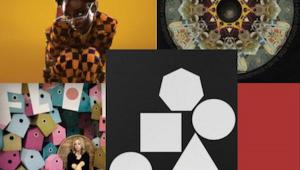Got Live If You Want It! Part 2
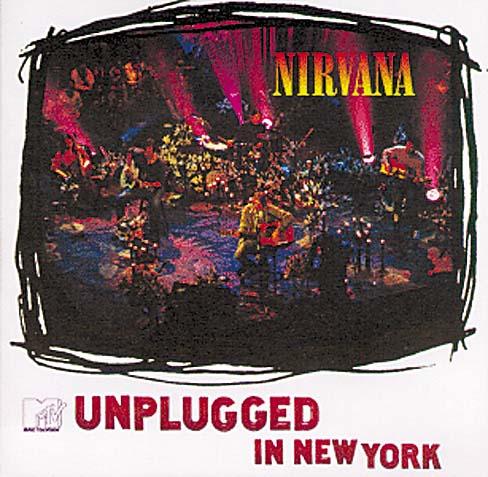
The Rolling Stones
Get Your Ya-Yas Out
Produced by The Rolling Stones and Glyn Johns
Engineered by Glyn Johns
No Mastering Credit
London NPS-5 LP/British Decca SKL-5065
Decca 6.28565 DT (LP)/ abkco (PolyGram) 80052 (CD)
Music:11
Sound:10
WARNING: While most of McGill's writing is done "live," this piece contains a few judiciously-placed overdubs.
It's 1970. Brian Jones is gone, The Beatles are on their way out, and The Stones have just reached their first peak, after an interesting pop-psychedelic period and a fine roots-country album, 1969's dark, powerful Let It Bleed. Keith Richards handled almost all the guitar on that one, and masterfully too, but he prefers the give-and-take of working with a partner, and on this set he is: trading licks with Mick Taylor, who toured with The Stones throughout the year. The result is this stunning document.
I never particularly dug that layered, slightly pretentious multi-announcer intro, but it does set the stage in a cut-and-paste Public Enemy sort of way. And while, in the opener, "Jumpin' Jack Flash," I always missed the jangling, Byrdsy guitar arpeggios from the studio version's chorus, they're not so much missing as muscled out of the way by Mick Taylor's creamy blues licks and Charlie Watts' locomotive kick drum. In other words, it's really just as good as the original and promises great things to come, the ragged-but-right harmonies soaring over The Stones' pirate ship like a ripped Jolly Roger. The former high harmony is now the melody, and Keith goes way up over that! Next, Mick stakes turf. "You don't want my TROUSERS to fall down, now do ya?" was never Chuck Berry's intro to "Carol," nor did Chuck and Johnny Johnson have a chance to pack the left-right punch of Taylor and Keith. This isn't what I mainly listen to The Stones for, but it's an excellent aperitif.
So we've established that my non-favorites here are amazing. Now for the really unbelievable stuff. On "Stray Cat Blues," as on "Jumpin' Jack," we swap a razor-sharp Keith-on-Keith studio arrangement for more Mick Taylor low-country boil. His guitar sounds like a snake trying to writhe its way out of the left speaker. They take the mystery they've cultivated all these years and let it slop recklessly all over the place like Halloween slimies. Sound is a good live-rock sound, especially given its 1969 vintage - it doesn't call attention to itself, either with breathtaking beauty or through any serious inadequacies.
Now the peaks. Again they take Keith's baroque road maps, these two from the recent Let It Bleed, and Dionysize 'em. Who knew "Love In Vain" wasn't already as good as it could get? Taylor's slide is a rich and decadent pleasure, and the train's just about to leave the station.
The live "Midnight Rambler" that follows (and closes Side 1) was this album's representative on the best-of Hot Rocks, and it deserved it. This song is a nasty little mini-symphony, wiping out the other early-70s tempo-change doofus opuses from "Roundabout" to "Stairway" while keeping roadhouse street smarts. It boasts the best features of the songs that precede it: the big "Jack" beat, the twin rhythm-guitar assault from "Carol," the sinister lyrical threat of "Stray Cat," and the spectacularly fluid lead-guitar work of "Love In Vain." Plus haunting banshee harp, crowd response that truly becomes part of the song, and the most exciting breakdown-and-buildup ever. For the last two minutes of this one, Keith is the greatest rhythm guitarist and Taylor the ultimate lead player. (Actually Keith is always the greatest rhythm guitarist, except when I'm listening to Meaty Beaty… or Tommy!)
If this were a studio album, Side Two might be the slightest of anti-climaxes (like from an A+ to an A), but on a live album we just keep on groovin'. "Sympathy for the Devil" is the song that misses its studio production the most, yet by this time they've got you so hypnotized by their two-guitar thing that it doesn't matter. This is a Richards showcase, powerful and succinct. It's followed by a not-terrible "Live With Me," where Keith unfortunately doesn't leave his own masterful studio bass line to Wyman; he doubles it Zeppishly on guitar, killing the sparse funk of the original.
Next we get Berry Breather II, "Little Queenie," as the piano makes Mardi Gras. "Charlie's good tonight, innie?" smirks Jagger. And then The Hits to close: "Honky Tonk Women," again perhaps not quite as brilliantly sparse as the original, but what a party (the crowd's really into it). And they close with one that clearly aces its model: the studio "Street Fighting Man" is like The Beatles' "Revolution," a good song with just a little too much classical restraint (especially given the topic), a sort of diagram of a classic rocker. Here The Stones let it loose, the whole band really taking off, Watts splattering his hi-hat like early Ringo, Richards working the grinding '70s-Keith "Brown Sugar" guitar sound for all it's worth, which is lots. So the record closes as it opens, with a grand gesture (this one musical). Greatest live album ever.
- Mike McGill
NIRVANA
Unplugged in New York
Produced by Nirvana and Scott Litt
No Engineering Credit
Mastered by Stephen Marcussen at Precision Mastering, L.A.
Geffen DGC-24727 (LP/CD)
Music: 11
Sound: 10
This album is a good argument for LPs: not only does it sound fine, but it came (in 1994) on gorgeous white vinyl, with beautiful cover photography and a cool, informative inner sleeve, for $8.99, if I remember right. Sonics: if it's not all-analog, they got darn close. The acoustic guitar-bass-and-drums lineup is augmented in places by Lori Goldston's cello and bassist Krist Novaselic's accordion, as well as various guest guitarists (happily not too often or too loud). The concert opens with the hit, "About a Girl," an instant classic with a great melody, and a perfect song for this arrangement (it trounces the version on Bleach). Next is "Come As You Are," familiar to most in its Nevermind incarnation. The more subdued harmony in the chorus here is effectively moody and atmospheric. "Jesus Doesn't Want Me For A Sunbeam" introduces Krist's accordion. The sad, spooky resonance of consecutive songs with choruses of "No I don't have a gun" and "Don't expect me to die" is too obvious to dwell on. Anyway, Nirvana sounds good with an accordion.
This is my favorite version of "The Man Who Sold The World" - warm Cobain covers cold Bowie, whose songs should be covered (and possibly improved!) more often. Musicians waste too much time covering songs that already have their definitive performances, simply as a "tribute."
Kurt's self-deprecating humor comes across as real throughout, thankfully stopping short of the "I suck and so does everything" vibe so many demi-Kurts assume. Someone (I think it's Cobain) has the nerve to say "that sounded good" after "Pennyroyal Tea" (which it did), although proletarian cynicism is restored by his bandmate's "shut up."
Pretty harmonies and wonderful high cello make "Dumb" a highlight, and "Polly" is great in any version (there are at least three). If anything, this is more powerful (though less polished) than the Nevermindstandout, because the chorus crashes in harder and rougher while the harmonies are just as good, with voices more naked and scarier. Novaselic's crisp bass was, on Nevermind and In Utero, the anchor for reckless guitar and thundering drums; here it's often the lead instrument by subtraction, and wins you over with its understated outlining of song structure.
They launch Side 2 with "On A Plane," and this version couldn't improve on the most roaring rocker they ever recorded (with the possible exception of "Smells Like Teen Spirit," which is hard to hear now as song rather than icon). But it's good. Cobain's songwriting really was so strong that most versions are valid and enjoyable (see Beatles Anthology). One value of this album is that it can be used to convert folks who can't take too much distortion to Kurt's songs. "Something In The Way," like "Polly," isn't a drastic reworking, although it's neat the way Cobain's acoustic guitar, here and elsewhere, overlaps Novaselic's bass to where you can lose track momentarily of which is which. It sounds like an acoustic guitar at a gig, not in a living room - a tastefully amplified acoustic, but not quite an unamplified one. It's a crisp, clean sound, which sounds bassy mainly because the player is choosing lots of low notes. I think Novaselic is playing an acoustic bass guitar with a pick-up on this album. This doesn't give the deep bottom of either a standup or a solid-body electric, but its midrangey tone does encourage the aforementioned neat, logical approach that holds the sound together.
Now we get a set of Meat Puppets material, Kurt crediting them loud and clear with flannel good karma. "Plateau" is pretty, as extra guitar is subtly integrated; rarely on the album is it obvious that two (or more) guitars are playing. Scott Litt (who got, to my ear, mixed results with R.E.M.) does a fine job of producing, along with the band. "Oh Me" is similarly moody, the mystery moving from mountaintop to farm like the similar sequence from "Ride My Llama" to "Pocahontas" on (Neil Young's) Rust Never Sleeps. A bit of down-home flavor to keep preciousness out of the mysticism. "One more," says Cobain, though there'll be encores. "Lake of Fire" continues the mid-tempo weirdness. This trio of songs also conjures up the middle of Side 1 of Music From Big Pink: timelessly American, using haunting religious images without the least trace of corn (unless it's distilled!).
"All Apologies" brings more serpentine bass/low guitar interplay. Kurt's singing is both raw and quite prominent here; no Marshalls to hide behind. I think it's great, but folks who require pretty or professional-sounding vocals may not dig this or the closer, "Where Did You Sleep Last Night." Their loss. "Sleep" is Leadbelly with cello, and it works!
This album is terrific, a winner on music, sound, and performance. Wonder if they'd have moved in this direction in the studio?
- Mike McGill
JOHNNY WINTER
Johnny Winter And Live
Produced by Johnny Winter and Rick Derringer
No engineering credit
No mastering credit
Columbia Records 30475 (LP)
Music: 9
Sound: 9
Johnny Winter And Live is one of the few albums that, from start to finish, fully justifies Winter's reputation as a guitar god. This 1970 set, recorded at the Fillmore East and Pirates' World in Florida, finds Winter at the peak of his early years for Columbia. With Rick Derringer on guitar, Randy Jo Hobbs on bass, and Bobby Caldwell on drums, this was easily the best group that Winter put together until he clicked with Muddy Waters' band a decade later. Playing a combination of blues, blues-drenched rock, and rock 'n' roll at a volume that equaled any band of the time, Winter sets down a standard here that few have topped since.
The kinetic energy that rolls off this disk is amazing. Derringer was the perfect foil for Winter, a sharp and gutsy player who constantly challenges Winter in a game of give and take. It's thrilling to hear how they take a set of cover songs, standards, and slow blues numbers and raise them to the sublime. Starting with a thunderous, wildly lascivious "Good Morning Little School Girl," it's immediately evident that Winter is going for the throat - and loving every second of it. The slow blues "It's My Own Fault" is either 12 minutes of admittedly trigger-happy, over-amped excess, or white-boy blues nirvana, depending on your perspective, but the focus of Winter's playing is impossible to miss. Side one ends with a crushing version of "Jumping Jack Flash" that must have rattled The Stones. Winter's guitar is as hot and focused as a laser, the hard-rock end of a single-note-lead tradition that includes Freddie King, Lonnie Mack and Cream-era Eric Clapton.
Side two gets down and very dirty with a medley of "Great Balls of Fire," "Long Tall Sally," and "Whole Lotta Shakin' Going On." Winter breaks out the slide for "Mean Town Blues," a frantic, brittle eight minutes that doesn't quite live up to the rest of the disk. They save the best for last, however (I stand on this: prove me wrong): the best-ever version of that old moldy, "Johnny B. Goode." The band is in hyper-drive at this point, ready to blast off the stage and through the roof - again, Winter's leads are perfectly focused, full of sex and swagger and the kind of confidence that comes from knowing that he can't be topped. As befits the intensity of all the players, it's hard to overstate how technically good this recording is. All the amp buzz, monstrous drums, and yowling vocals are in sharp relief, the guitars rev like Indy cars, all dials are pegged into the red. At its best, this is a classic: rock of ages.
- Carl Hanni
NEIL YOUNG
Time Fades Away
Produced by Elliot Mazer and Neil Young
No engineering credit
Reprise MS2151 (LP)
Music: 9
Sound: 8
This nearly forgotten LP was a first indicator of the decades of eccentric musical choices to come from Neil Young. It's not that the songs or performances on Time Fades Away were particularly offbeat or difficult, but the proof is in the timing. It's easy to forget (Reprise tried to), but this album, recorded around the country and released in 1973, was Young's first album after the phenomenal success of Harvest and After the Gold Rush, two wildly popular albums that were supposed to cement Young's reputation as a moody hippie troubadour.
Instead of capitalizing on the formula, Young did what he's been doing ever since: subverted all expectations. He struck out on his own and released a live album of dark, unknown material. What everyone seemed to miss at the time was what a great album it is.
Young's cohorts at the time were Ben Keith on slide and steel guitar, Jack Nitzsche on piano, Tim Drummond on bass, and Johnny Barbata on drums, with appearances by David Crosby and Graham Nash. In addition to three lovely solo numbers that Young delivers at the piano ("Journey Thru The Past," "Love In Mind," "The Bridge"), the album features five of Young's best rock and country rock songs of the '70s.
The title track is one of those casual twangy country numbers that Young effortlessly tosses off and has been doing for decades, the musical equivalent of Charles Bukowski's writing: it looks and sounds easy, but just try doing it yourself. "Don't Be Denied" is both bracing autobiography and a statement of purpose; "Yonder Stands The Sinner" a brawling rocker; and "L.A." is a classic pot-shot/love letter to Young's adopted home, wrapped around Keith's weeping steel guitar. The disc ends with "Last Dance," a sprawling, Crazy Horse-style hard-rock number where Young's atonal leads and Keith's slide trade punches like drunks in an alley way.
As is usually the case, Young brings out both the best and the most jagged and unschooled in those he plays with. Take "Time Fades Away" as an example: built around Nitzsche's honky-tonk piano, Barbata plays just behind the beat, Drummond plunks out a popping, simplistic line while Young and Keith wail away off-key and unconcerned - it sounds like it's about ready to fall apart at any minute, glorious wreckage that only an artist as gifted and willfully nonchalant as Young could finesse.
The recording is simple, raw, and perfectly effective: turn on the deck, crank up all the mids and highs, and let the band burn it out. Time may fade away, but Neil Young certainly hasn't, and this early recording is a milestone in the fascinating journey of a truly towering artist.
- Carl Hanni
COL. BRUCE HAMPTON & THE AQUARIUM RESCUE UNIT
Col. Bruce Hampton & The Aquarium Rescue Unit
Produced by Johnny Sandlin
Engineered by Kooster McAllister
Mastered by Benny Quinn at Masterfonics, Nashville, TN
Capricorn 9 42000-2 (CD)
Music:7
Sound:7
From a long, largely obscure career begun in 1970 with an ironic major-label debut, Music To Eat, this staggering live record from 1991 may prove to be the most remarkable of the sporadic documents left by Hampton's peculiarly American dada genius. As gifted as his various bands tended to be, up until this point, none delivered the jaw-dropping technique of this fully improvisational septet which could run with Dixie Dregs and/or Captain Beefheart's Magic Band.
Combine their technique with a memorable analog master that catches this rock/jazz/bluegrass/art-band farce of ferocious intensity, still rising to its powers on the eve of the first Horde tour, and you've got a topic for discussion.
Hampton used to stress that the ARU never rehearsed. Each performance would find them naked in the laboratory thinking up, on the spot, what possible music and mischief they could delight themselves with from the leftovers of the previous gig.
Mind you, they did have a method, but one would be hard pressed to elucidate exactly what it was - considering that they freely covered American blues, gospel, R&B, and soul classics while taking great but not irreverent liberties with the interpretations. Those were sprinkled them amongst a set of original tunes and ideas that were themselves non-sensically funny and in constant flux.
Like one of his admirers, the late Frank Zappa, Hampton's resultant stage “phenomena” is a kind of amplified plastic head music rooted in nothing more than the friendly notions of free time and silly wisdom. And chops.
Hampton himself is a man of modest musical ability, and here the eccentric ticklings on his homemade “chazoid” and personal-best vocals manage to hilariously counterpoint the virtuosic dazzle of the ARU. Matt Mundy's electric mandolin and Jimmy Herring's electric guitar are presented left and right, each inviting the other into blindingly succinct statements fresh to the soloing logic of their respective ancestors. Oteil Burbridge plays a feverish fretless bass, often scat singing in unison with his fingered cadenzas while the vigorous drumming of “Apt. Q258” (Jeff Sipe) spans the gamut of tempo and style, from bluegrass high-gear to easy jazz swing, from ambient beatnik patter to polyrock. Chuck Leavell, on piano & organ, and Count Mbutu on congas color the remaining available air. All told, it's a dust-loosening, gnomic juggernaut of quick-step precision and howling mayhem.
The live debut of this band has what I think all concert recordings should have at the very least: crisp, detailed images and a sense of venue dimensions. The transients are quite fast, instruments sharply focused though overlapped in the soundstage, and the hall ambience is neither flat nor exaggerated. The digital editing and remix does render instruments with a trace of hardness. But since the frequently full bandwidth and up-tempo songs do not allow one to linger long on hall harmonics and decay, the penalty seems small. This is not the typically lifeless monitor perspective, it's a front-row seat with some space behind you, and it doesn't get much better.
- Steve Taylor
GENTLE GIANT
The Official Live Gentle Giant: Playing The Fool
Produced by Gentle Giant
Engineered by Paul Northfield
No mastering credit
Chrysalis CTY 1133 (British Import) / Capitol SKBB-11592 (Domestic) (2 LPs)
Music: 9
Sound: 8
Round about 1970, the emerging progressive-rock act Gentle Giant took the speculative idea of highly organized music and extruded it into numerous baroque variants. Ambitious recordings thereafter appeared of rugmaker-like import, which did not always adapt well to the stage. Indeed, few progressive-rock ensembles seemed able to go brilliantly beyond their crafted studio creations onstage during the halcyon '70s, let alone with a matching sensitivity for good sound.
Carl Baugher reviews one in this issue: Frank Zappa & The Mothers' Roxy & Elsewhere (1974). Another would be England's Gentle Giant and their bootleg-busting "Official Live” album, Playing The Fool (1977).
Recorded “au natural” (without overdubs) during the European tour from September to October 1976, Playing The Fool catches Gentle Giant at perhaps the zenith of many peaks in a 10-year career, with its most impressive studio work behind it. On Playing The Fool, Giant draws from this wealth of incomparable material, producing fresh readings and intriguing new arrangements as intricate or more so than the originals. Favorite selections and medleys from Gentle Giant, Three Friends, Octopus, In A Glass House, The Power and The Glory, Free Hand, and Interview are all here, attesting to the group's dedication to a music capable of offering continual discovery of its many parts.
A live Gentle Giant show was a considerable challenge to engineer. For one thing, all members of this quintet routinely sang and played a minimum of four instruments while on tour. The difficult mix of amplified and acoustic armory including the basic rock tools plus recorders, acoustic guitars, vibes, cello, violin and saxophone (30 instruments in all) made for severe dynamics, going from intimate, purely acoustic passages to classic power crescendos (hence the name Gentle Giant?).
Playing The Fool is not a perfect mix of the two, but both sides are flatteringly displayed with an immediacy granted by the sensibly chosen, modest-sized rooms from which these tracks were gleaned. These recordings have warm bite, non-literal but creative soundstaging, and fairly wide bandwidth. That Paul Northfield manages to capture all of this so evenly throughout is an achievement in and of itself.
Even more extraordinary is Gentle Giant's unique playing and writing talents. Hinting at medieval troubadours, chamber music, avant-garde, blues, rock 'n' roll, and plenty more, its music was a transcending arithmetical summation thereof - by turns exuberant, sober, and often flat-out amazing. Here the players are in magnificent form, magically dispensing the famous interlocking a cappella passages, recorder fugues, the unheard-of clockwork interplay of persistently unusual meter, and rockin' good vibes. This is sumptuous, compact, nicely recorded evidence that Gentle Giant was derivative of no one, and technically, excelled by few during the 1970s. Most crucial of all, its musicians delivered such heady goods with unmistakable joy.
Release preference on vinyl: original Chrysalis British import pressing, domestic Capitol pressing, British Essential Records reissue pressing. The first two CD reissues are already out of print (Castle Communications/Essential Records and Terrapin Records). The Castle Communications/Essential CD is very good, adding more definition to cymbals and bass but losing the warm meshing of all instruments and truncating valuable space-describing room echoes. A third CD reissue is the first domestic release on One Way Records, which I've not had the benefit of hearing [though One Way is quickly making a name for itself with its quality remasterings - Ed].
- Steve Taylor
BLUE ÖYSTER CULT
On Your Feet Or On Your Knees
Produced by
Engineered by
Mastered by
Columbia PG33371 (2 LP)
Music 10
Sound 6
THE ALLMAN BROTHERS BAND
At Fillmore East
Produced by
Engineered by
Mastered by
Capricorn SD2-802 (“pink label” 2 LP)
Music 10
Sound 8
It's not an exaggeration to say that, to a large degree, these two albums are responsible for making me the guitar player I am today - maybe even to a large degree the person I am today. The influence they have had and still have on me are beyond estimation or quantification, and whenever I listen, I still get the same electric thrill I got back when I first heard these records as a teenager who lived and dreamed electric-guitar playing every waking and many sleeping moments. I used to fall asleep, Telecaster in hand, amp still buzzing, after practicing and practicing, trying to become as good as the guitar heroes who dazzled me with their out-of-this-world playing.
That is, when I wasn't literally wearing out the grooves listening to On Your Feet Or On Your Knees and The Allman Brothers Band At Fillmore East, two utterly awe-inspiring live LPs whose music shakes my very soul and whose guitarists affect me with nothing less than hypnotic power. You'd best believe the records I listened to while writing this were not my original copies!
To this day, there is no rock band I find more compelling than Blue Öyster Cult, a band that combines brilliant songwriting and musicianship, lyrics that are at times darkly mysterious and at times off the wall, and the ability to rock hard, fast, loud, and intense. (They can also shift gears and create music with a slow, smoldering intensity, like the stunning, majestic “Then Came the Last Days of May.”) And there is no guitarist I find more compelling than BÖC's secret weapon, Buck Dharma, a man who combines ferocious intensity and energy with seemingly boundless melodic imagination. Where most hard-rock guitarists go “weedelee-weedelee-wee” and run the same clichéd riff treadmill over and over again ad nauseam, Dharma spins out mind-blowing solo after jaw-dropping solo on OYFOOYK (as it is affectionately abbreviated) without repetition, with a soaring, harmonically rich Gibson-through-Marshall tone. Why Dharma isn't mentioned in the same breath as Hendrix, Beck, and Clapton I'll never know, 'cause he sure as hell should be.
On Your Feet Or On Your Knees contains choice material from the first three astonishing - and I mean astonishing - BÖC studio albums, Blue Öyster Cult, Tyranny and Mutation and Secret Treaties, including now-classics such as a blazing version of “Cities on Flame (With Rock and Roll),” an incendiary “Hot Rails to Hell” (why not keep the fire metaphor going - it's appropriate, as these versions are smokin'), BD's showpiece, “Buck's Boogie,” “ME262,” the testament to adrenaline that is “The Red and the Black,” “Before the Kiss (A Redcap),” and “Harvester of Eyes.” (I told you they could be lyrically off the wall; just dig some of those song titles. Another reason why I love the band: one-dimensional they ain't!) In addition, the band (Dharma, singer/guitarist Eric Bloom, guitarist/keyboardist Allen Lanier, bassist Joe Bouchard, and drummer Albert Bouchard) rip through The Yardbirds' “I Ain't Got You” and Steppenwolf's “Born to be Wild,” complete with a cacophonous crossed-guitars finale (yep, BÖC used to end its shows with Bloom and Dharma rubbing their guitar necks together at full volume; kinda makes a train wreck sound like Zamfir by comparison).
If only the sound were better; the recording is murky, with a somewhat indistinct mix, rumbly, hard-to-hear bass, a truncated dynamic range, and a spatially flat perspective. Oh, you can hear everything OK - Dharma's guitar cuts through the mix the way it should and there's decent upper-midrange presence - but it sounds for all the world as if you're listening in the middle of a large-ish hall with bad acoustics. Then again, it could be argued that that's a totally realistic portrayal of what a lot of rock concerts in the '70s actually sounded like. It sounds a lot better if you turn it up to louder than average level; then, the instruments cut through more with vastly “improved” presence. Still, the music is fabulous, so it doesn't bother me. If you want to hear a live Blue Öyster Cult recording that does sound excellent, check out the superb Some Enchanted Evening (Columbia JC35563), a later 1978 LP that has a punchy, dynamic, wideband mix to complement stunning renditions of songs like “(Don't Fear) the Reaper,” “ETI,” “Godzilla,” and other towering titans of the BÖC canon.
While you're at it, if you really want to hear the guys of Blue Öyster Cult at their live best, check them out the next time they play in your burg. They're still burnin' and sound better than ever - you won't be disappointed.
Is there a reader of this magazine who's never heard The Allman Brothers Band at Fillmore East? I suppose there must be, but when I was growing up their popularity was overwhelming. I remember my first week as a college freshman up at Albany State in 1973, when I walked around Colonial Quad and literally dozens of people were blasting the Allman Brothers out their dorm room windows - I could choose whatever song I wanted to hear just by picking the right spot around the quad! The band that, along with Capricorn Records, put Southern Rock on the map, they were far more versatile and virtuosic than any such simple appellation could suffice to describe - yet they were imbued with the musical influences and lifestyle of the South and their music could have come from nowhere else.
The Allman Brothers at Fillmore East is their monument, their masterpiece. From the first roaring Duane Allman slide-guitar notes leading off “Statesboro Blues,” you know you're in for a hair-raising musical ride. The six-piece band - Duane Allman and Dickey Betts on guitars, Gregg Allman on organ and vocals, Berry Oakley on bass, and Jai Johanny Johanson and Butch Trucks on drums and percussion - creates a huge interlocking ensemble sound, rhythmically charged and tight as hell. Most remarkable, however, is their ability to stretch and soar on dizzying improvisational flights, fueled by the twin-guitar virtuosity of Duane Allman and Betts, and the album's double length provides plenty of room for them to fly (two sides are each taken up by a single song, the 19-minute-plus “You Don't Love Me” and the immortal, 22-minutes-and-change “Whipping Post,” and the entire LP contains only seven songs.)
And man, can these guys play. Gregg Allman's vocals are so intense I don't know how he didn't implode while singing them, and his organ playing is rich and deeply soulful. The two drummers and Oakley bob and weave and breathe along with the music like some kind of living thing, all the while holding down some of the most bad-ass grooves ever heard on this planet. And Duane Allman and Betts...what can I say without exhausting my feeble bag of superlatives? Complementing each other like no other dual-guitar team before or since (with the exception of Jimmy Bryant and Speedy West), both men play brilliantly throughout, either trading solos or playing their trademark intricate two-guitar harmony leads, as on the spellbinding “In Memory of Elizabeth Reed.” When this album first hit the scene, it was almost shocking in its effect and blew peoples' minds the way few albums have before or since. This may be the most influential live rock album ever.
I'm happy to say the sound quality is terrific! My original pink-label Capricorn pressing (originally I had a yellow-label Atco pressing, but like I said, wore it out) has a superb tonal balance with solid, punchy, and tight bass, a warm, rich midrange, and open, extended highs. Detail and resolution are excellent, imaging is good if not laser-precise (and you wouldn't hear such artificially etched imaging at a rock concert anyway, for fark's sake) and yes, there's even a credible soundstage, wide and somewhat deep, with a good mix of direct and hall sound. When you turn this up, you are there at the Fillmore East in 1971, my friends - this is one of the most well-recorded live albums ever. I've never heard any of the CD reissues, and the last time I played my Atco pressing was on a stereo worth about $200, so I can't comment on that either, but this pink-label pressing - man! It's worth the effort and expense to find a copy.
- Frank Doris






